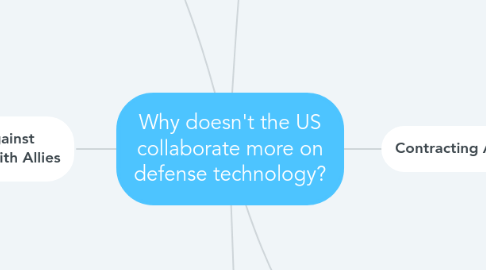
1. Lack of (awareness) of Opportunities
1.1. “The problem isn’t that the DoD doesn’t know how to buy; it is that it doesn’t know what to buy.” (Brookings)
2. Lack of Political/ Societal Will
2.1. Courts, media, corporate culture impede public-private cooperation (defense.gov)
2.1.1. E.g. backlash against Google Project maven in 2017
2.2. "Not invented here" syndrome (Defense Post)
2.3. More recent emphasis on reform
2.3.1. “Presenting a credible deterrent to potential adversaries requires us to develop and field emerging technologies," Barbara McQuiston, told a Senate Appropriations subcommittee. "We must innovate at speed and scale. Success requires more than a go-it-alone approach. We must explore more flexible partnerships with the private sector and academia, with small businesses and [historically black colleges and universities]. We must reinvigorate our federal research capabilities, elevate science, promote technology and expand partnerships with our allies." (defense.gov)
3. Impediments against Collaboration with Allies
3.1. Export control regime
3.1.1. e.g. allies need Tier 1 Strategic trade authorization (Defense post)
3.1.2. Recommendation: "permanent umbrella body" to oversee R&D collaboration with allies, creation of joint research units between countries, identification of joint capability gaps, minimization of duplication and direct resources bases on shared policy priorities (Defense Post)
3.2. Collaboration challenge with Japan (National Defense Magazine)
3.2.1. Funding structures prohibit internal R&D investments
3.2.2. Cultural barriers
3.2.3. Restrictions/ challenges with overseas exports (bans on arms exports were only lifted in 2014) / lack of "presence"
3.3. Case Studies
3.3.1. Case study:Standard-Missile 3 Interceptor (Raytheon + Mitsubishi Heavy Industries)
3.3.2. "The Quad" (Quadrilateral Security Dialogue) between US, Australia, Japan, India)
3.3.2.1. Fund production of vaccines
3.3.2.2. Cooperation on clean energy solutions, including supply chain
3.3.2.3. Sustainable use of space/ sharing of sat-based remote sensing capabilities to monitor climate change
3.3.2.4. Advancing the deployment of 5G
3.3.2.5. Cybersecurity
4. Challenges in Assessing/ Establishing Value
5. Organizational and Institutional Barriers
5.1. Misaligned incentive structure for pursuing emerging technologies
5.1.1. Use of taxpayer dollars results in aversion to riskier tech projects and congressional questioning over perceived wasted resources (defense post)
5.1.1.1. Recommendation: Need for fewer punishing mechanisms? e.g. reduced or zeroed budget authorizations
5.2. Congressional Requirements
5.2.1. Prevents Pentagon from retiring weaponry
5.2.2. Requirements deigned to reduce waste/ accelerate innovation sometimes backfire
5.2.3. "People say the DoD should be run like a business ... well in business you fail, you go on. If DoD fails, there are new laws and procurement rules." - Gertler (veteran military aviation analyst)
5.3. Effectiveness of organizations set up to address this?
5.3.1. Defense Innovation Unit was set up to bring tech developed in the private sector to the DoD
5.3.2. DARPA is responsible for academia/ private sector partnerships
6. Contracting Approach
6.1. Pentagon: long-term investments in a small number of weapons systems vs China: experiment with many versions of similar technology (Washington Post)
6.1.1. China's advantage
6.1.1.1. Adopted "military-civil fusion" (Washington Post)
6.1.1.2. Able to 'seamlessly capitalize on private sector advances" (Washington Post)
6.1.1.3. Able to exploit dual-use products / force technology transfers (Washington Post)
6.1.1.4. Advantage of scale
6.1.1.5. Willingness to use espionage
6.1.1.6. Long-term vision
6.1.2. US advantage
6.1.2.1. abundance of friends and allies
6.1.3. “But the pace of military innovation slowed in the 1960s with the advent of a centralized procurement system that prioritized performance and predictability over speed... China’s defense transformation has been guided by a principle known as “military-civil fusion,” which aims to allow the state to seamlessly capitalize on private-sector advances. Overseen personally by President Xi Jinping, the strategy can include exploitation of dual-use products or even forced technology transfers.” (Washington Post)
